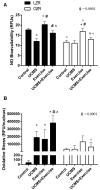Role of Chronic Stress and Exercise on Microvascular Function in Metabolic Syndrome
- PMID: 29271845
- PMCID: PMC5898979
- DOI: 10.1249/MSS.0000000000001531
Role of Chronic Stress and Exercise on Microvascular Function in Metabolic Syndrome
Abstract
Purpose: The present study examined the effect of unpredictable chronic mild stress (UCMS) on peripheral microvessel function in healthy and metabolic syndrome (MetS) rodents and whether exercise training could prevent the vascular dysfunction associated with UCMS.
Methods: Lean and obese (model of MetS) Zucker rats (LZR and OZR) were exposed to 8 wk of UCMS, exercise (Ex), UCMS + Ex, or control conditions. At the end of the intervention, gracilis arterioles (GA) were isolated and hung in a pressurized myobath to assess endothelium-dependent (EDD) and endothelium-independent (EID) dilation. Levels of nitric oxide (NO) and reactive oxygen species (ROS) were measured through 4-amino-5-methylamino-2',7'-difluorofluorescein diacetate and dihydroethidium staining, respectively.
Results: Compared with LZR controls, EDD and EID were lower (P = 0.0001) in LZR-UCMS. The OZR-Ex group had a higher EDD (P = 0.0001) and EID (P = 0.003) compared with OZR controls, whereas only a difference in EDD (P = 0.01) was noted between the LZR-control and LZR-Ex groups. Importantly, EDD and EID were higher in the LZR (P = 0.0001; P = 0.02) and OZR (P = 0.0001; P = 0.02) UCMS + Ex groups compared with UCMS alone. Lower NO bioavailability and higher ROS were noted in the LZR-UCMS group (P = 0.0001), but not OZR-UCMS, compared with controls. The Ex and UCMS-Ex groups had higher NO bioavailability (P = 0.0001) compared with the control and UCMS groups, but ROS levels remained high.
Conclusions: The comorbidity between UCMS and MetS does not exacerbate the effects of one another on GA EDD responses, but does lead to the development of other vasculopathy adaptations, which can be partially explained by alterations in NO and ROS production. Importantly, exercise training alleviates most of the negative effects of UCMS on GA function.
Conflict of interest statement
The authors declare no conflicts of interest. The results of the present study do not constitute endorsement by the American College of Sports Medicine and are presented clearly, honestly, and without fabrication, falsification, or inappropriate data manipulation.
Figures



Similar articles
-
Psychological stress-induced cerebrovascular dysfunction: the role of metabolic syndrome and exercise.Exp Physiol. 2018 May 1;103(5):761-776. doi: 10.1113/EP086892. Epub 2018 Mar 25. Exp Physiol. 2018. PMID: 29436736 Free PMC article.
-
Chronic stress induced perivascular adipose tissue impairment of aortic function and the therapeutic effect of exercise.Exp Physiol. 2021 Jun;106(6):1343-1358. doi: 10.1113/EP089449. Epub 2021 May 14. Exp Physiol. 2021. PMID: 33913209 Free PMC article.
-
Metabolic syndrome impairs reactivity and wall mechanics of cerebral resistance arteries in obese Zucker rats.Am J Physiol Heart Circ Physiol. 2015 Dec 1;309(11):H1846-59. doi: 10.1152/ajpheart.00691.2015. Epub 2015 Oct 16. Am J Physiol Heart Circ Physiol. 2015. PMID: 26475592 Free PMC article.
-
Altered post-capillary and collecting venular reactivity in skeletal muscle with metabolic syndrome.J Physiol. 2017 Aug 1;595(15):5159-5174. doi: 10.1113/JP274291. Epub 2017 Jul 5. J Physiol. 2017. PMID: 28556909 Free PMC article.
-
Vascular function in the metabolic syndrome and the effects on skeletal muscle perfusion: lessons from the obese Zucker rat.Essays Biochem. 2006;42:145-61. doi: 10.1042/bse0420145. Essays Biochem. 2006. PMID: 17144886 Review.
Cited by
-
Integrative Strategies for Preventing and Managing Metabolic Syndrome: The Impact of Exercise and Diet on Oxidative Stress Reduction-A Review.Life (Basel). 2025 May 8;15(5):757. doi: 10.3390/life15050757. Life (Basel). 2025. PMID: 40430185 Free PMC article. Review.
-
Role and mechanism of PVN-sympathetic-adipose circuit in depression and insulin resistance induced by chronic stress.EMBO Rep. 2023 Dec 6;24(12):e57176. doi: 10.15252/embr.202357176. Epub 2023 Oct 23. EMBO Rep. 2023. PMID: 37870400 Free PMC article.
-
Burnout and Metabolic Syndrome in Female Nurses: An Observational Study.Int J Environ Res Public Health. 2019 Jun 5;16(11):1993. doi: 10.3390/ijerph16111993. Int J Environ Res Public Health. 2019. PMID: 31195593 Free PMC article.
-
Voluntary Exercise-Induced Activation of Thyroid Axis and Reduction of White Fat Depots Is Attenuated by Chronic Stress in a Sex Dimorphic Pattern in Adult Rats.Front Endocrinol (Lausanne). 2019 Jun 26;10:418. doi: 10.3389/fendo.2019.00418. eCollection 2019. Front Endocrinol (Lausanne). 2019. PMID: 31297093 Free PMC article.
-
Effects of impaired microvascular flow regulation on metabolism-perfusion matching and organ function.Microcirculation. 2021 Apr;28(3):e12673. doi: 10.1111/micc.12673. Epub 2020 Dec 21. Microcirculation. 2021. PMID: 33236393 Free PMC article. Review.
References
-
- Ogden CL, Carroll MD, Kit BK, Flegal KM. Prevalence of childhood and adult obesity in the United States, 2011–2012. JAMA [Internet] 2014;311(8):806–14. Available from: http://www.ncbi.nlm.nih.gov/pubmed/24570244%5Cnhttp://jama.jamanetwork.c.... - PMC - PubMed
-
- Malik S, Wong ND, Franklin SS, Kamath TV, L’Italien GJ, Pio JR, et al. Impact of the metabolic syndrome on mortality from coronary heart disease, cardiovascular disease, and all causes in United States adults. Circulation. 2004;110:1245–50. - PubMed
-
- Ervin RB. Prevalence of metabolic syndrome among adults 20 years of age and over, by sex, age, race and ethnicity, and body mass index: United States, 2003–2006. Natl Health Stat Report. 2009;13:1–7. - PubMed
-
- Maksimovic M, Vlajinac H, Radak D, Marinkovic J, Jorga J. Relationship between peripheral arterial disease and metabolic syndrome. Angiology [Internet] 2009;60:546–53. Available from: http://www.ncbi.nlm.nih.gov/pubmed/19147526. - PubMed
Publication types
MeSH terms
Substances
Grants and funding
- P20 GM109098/GM/NIGMS NIH HHS/United States
- 14PRE20380386/AHA/American Heart Association-American Stroke Association/United States
- P01 AG043376/AG/NIA NIH HHS/United States
- U54 GM104942/GM/NIGMS NIH HHS/United States
- 11CRP7370056/AHA/American Heart Association-American Stroke Association/United States
LinkOut - more resources
Full Text Sources
Other Literature Sources
Medical

